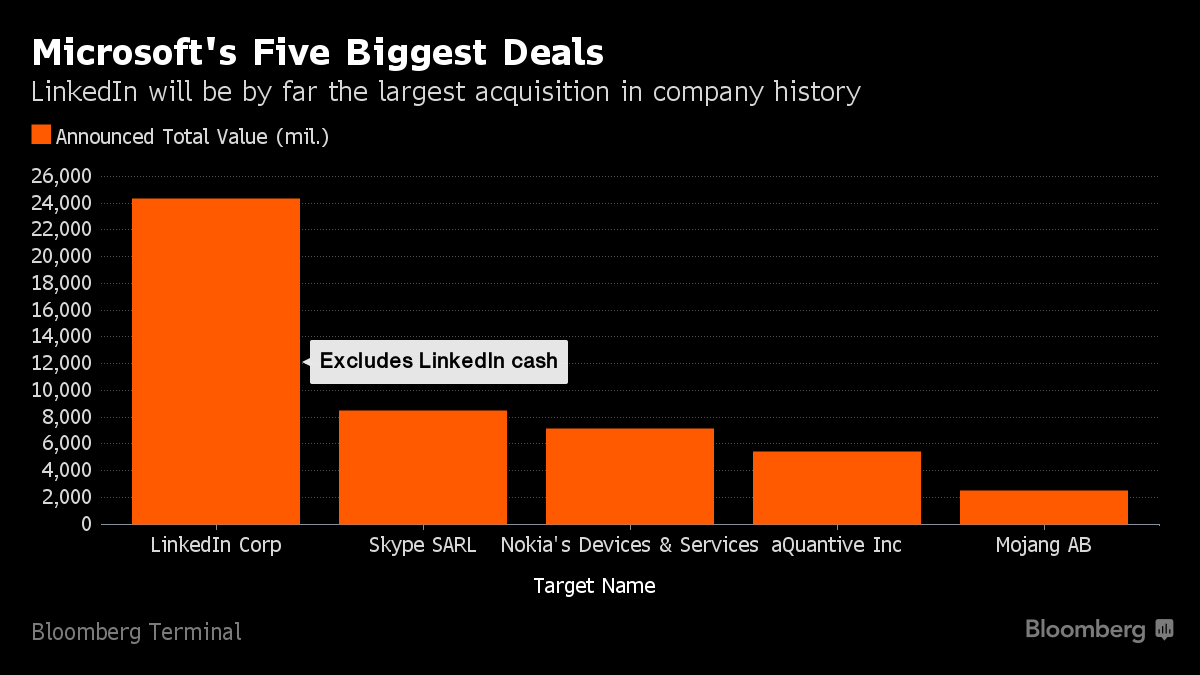In June Microsoft agreed to buy LinkedIn for $26.2 billion in the largest acquisition of its time, betting the professional social network can recharge the company’s software offerings despite recent difficulties.

Microsoft never had a good social media platform and their search and web analytics still can’t shake a stick a Google’s. Although Microsoft has done well with the Surface, Office 365, and business software tools like SharePoint, OneDrive/Cloud, and Azure, they have struggled with their Nokia phones running on Windows – wasting money. LinkedIn is fiercely respected among recruiters and job seekers, and had great income streams in prior quarters. Yet they have scaled back what they offer to free members, removed their events feature years ago, and have made many user and cosmetic changes that have forced some people to use LinkedIn only as a tool to promote their own sites which they can directly control and monetize – thus driving their revenue and market appeal down.
Buying LinkedIn cost Microsoft $196 per share, a 50% premium from their before sale announcement price. This is a win for LinkedIn shareholders, and is likely a win for Microsoft in the long run. Once Microsoft integrates its systems with LinkedIn it will have a giant CRM like Salesforce.com or Oracle. This CRM will be used to tastefully listen and market Microsoft subscription solutions to LinkedIn users, among related items. Yet even if that effort backfires it does not matter because LinkedIn by itself produces good income. Thus, with some user experience tweaks, for example, bringing back the event feature which will allow them to see what interests and products can be inferred from event registrations. Facebook presently does a good job at this. Even if a person does not go to the event they have still indicated interest by registering, and that is valuable data especially when cross referenced with other LinkedIn data. The key is data mining, analytics, cloud services, and tastefully cross marketing and selling these and yet unknown services.
Observing the above, it’s of no surprise that Salesforce was one of the early bidders to buy LinkedIn but it is a surprise that they lost out since they like Oracle have such a nasty track record of successful acquisitions. Recently in a securities filing, LinkedIn disclosed an email from Salesforce CEO Marc Benioff in which he says that Salesforce would have increased its bid and restructured its offer had it been giving an opportunity by LinkedIn.
“Reflecting on the additional proposals it made after LinkedIn and Microsoft agreed to exclusivity, the email indicated that Party A would have bid much higher and made changes to the stock/cash components of its offers, but it was acting without communications from LinkedIn,” the filing says. “The Transactions Committee also considered the contractual provisions contained in the definitive merger agreement with Microsoft, including those relating to discussions with third parties, and determined not to respond.” (Salesforce’s Benioff says he would have paid more than $26B for LinkedIn).
Yet after carefully reviewing how it handled the bidding process to make sure it wasn’t legally exposed, LinkedIn’s deal teams decided not to respond to the email. Although, the Benioff email didn’t say how much more he would have offered – many new sources are speculating $4.2 to $4.7 billion more than Microsoft. Let’s hope both companies continue to compete to make the industry better.
By Jeremy Swenson
